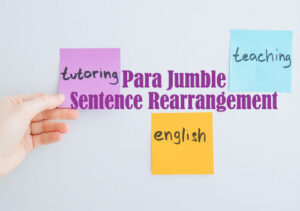Para Jumbles for IBPS PO English Language Question Papers
The Para Jumbles for IBPS PO Question Papers are published here to help the PO Exam applicants. A large number of aspirants are searching on the Internet for the Institute of Banking Personnel Selection Probationary Officer Para Jumbles Model Papers.

It is the right place for those IBPS Probationary Officer Sentence Rearrangement Previous Papers. Since, we are providing the valuable information about the Institute of Banking Personnel Selection PO Para Jumbles Last Ten Years Exam Question Papers & Answers.
Because we have given all the Sample Papers on Para Jumbles for IBPS PO. Just in simple steps, you will download the Institute of Banking Personnel Selection PO Exam Sentence Rearrangement Papers freely.
Eligible aspirants can check & download the Para Jumbles for IBPS PO Question Paper with Answers for Institute of Banking Personnel Selection Exam from the provided link. Aspirants searching for Para Jumbles for IBPS PO can also download all questions from our website.
Para Jumble Questions for IBPS PO from Previous Years
Directions: Rearrange the following sentences in the proper sequence to form a meaningful paragraph; then answer the questions given below them.
Exercise – 1
(A) It takes its recourse to progressive march towards perfection.
(B) But, one may conclude, while science is inclined towards reason, spiritualism is the essence of religion.
(C) In religion deviation from the set course is permissible, though some more rationalistic religious leaders also allow questioning and their satisfactory answers.
(D) Many people believe that science and religion are contrary to each other.
(E) The tools of religion, on the other hand, are faith, intuition, and the spoken word of the enlightened.
(F) The method of science is observation, experiment and experience.
(G) There is no doubt that the methods of science and religion are different.
1. Which of the following will be the SECOND sentence?
1) F
2) E
3) D
4) B
5) G
2. Which of the following will be the FOURTH sentence?
1) B
2) A
3) D
4) F
5) C
3. Which of the following will be the LAST sentence?
1) C
2) A
3) D
4) B
5) E
4. Which of the following will be the FIRST sentence?
1) C
2) B
3) D
4) F
5) A
5. Which of the following will be the SIXTH sentence?
1) C
2) F
3) A
4) G
5) D
Exercise – 2
A) But all three have one focus – individual performance improvement.
B) The importance of each component will vary from organization to organization according to the complexity of the operations.
C) They are individual development, career development and organizational development.
D) Since individual performance improvement is the heart of HRD programme, HRD can be described as the area of congruence among the three components.
E) There are three fundamental component areas of human resource development.
F) It will also vary according to the criticality of human resources to organizational efficiency and organization’s commitment to improve human resources.
1. Which of the following will be the SIXTH sentence?
1) C
2) F
3) B
4) D
5) A
2. Which of the following will be the FOURTH sentence?
1) F
2) C
3) D
4) B
5) A
3. Which of the following will be the SECOND sentence?
1) D
2) E
3) B
4) F
5) C
4. Which of the following will be the FIRST sentence?
1) D
2) E
3) F
4) B
5) C
Exercise – 3
A. It was further revived by a Boston publishing firm, and from that time Mother Goose continued and grew in fame and interest till date.
B. The first collection of verses under her name was published in London in book form by John Newberry.
C. These were known long before they were designated as Mother Goose rhymes.
D. Some rhymes can be traced to popular ballads, folk songs and games, political satire, ancient proverbs, cries of street vendors, real or legendary events.
E. About twenty-five years later the book was reprinted in the United States in Worcester, Massachusetts.
F. In fact, until the eighteenth century Mother Goose did not have a name in print in English literature.
1. Which of the following will be the last sentence?
1) A
2) B
3) C
4) D
5) E
2. Which of the following will be the fourth sentence?
1) F
2) E
3) D
4) C
5) B
3. Which of the following will be the fifth sentence?
1) F
2) E
3) D
4) C
5) B
4. Which of the following will be the first sentence?
1) A
2) B
3) C
4) D
5) E
5. Which of the following will be the second sentence?
1) A
2) B
3) C
4) D
5) E
Previous Year Question Papers |
Exercise – 4
A. The north is bordered by mountain ranges while the remaining sides of Greece are enclosed by the Mediterranean sea.
B. The people there were called the Greeks.
C. Greeks, therefore became good navigators.
D. The typical character of Green civilisation is due to the geographic conditions prevailing there.
E. The name Greece comes from one of the islands to the south-east of Europe known as Graecia.
1. Which of the following will be the THIRD sentence?
1) C
2) D
3) A
4) B
5) E
2. Which of the following will be the FOURTH sentence?
1) B
2) E
3) A
4) D
5) C
3. Which of the following will be the SECOND sentence?
1) A
2) E
3) D
4) C
5) B
4. Which of the following will be the LAST sentence?
1) C
2) D
3) B
4) E
5) A
5. Which of the following will be the FIRST sentence?
1) B
2) C
3) A
4) E
5) D
Exercise – 5
A) Some people believe that at present its importance is decreasing because of rapid economic and social changes.
B) The extent of its importance may be slightly less in cities as compared to rural communities.
C) Some even go to the extreme and say that it will soon become obsolete because of these changes.
D) The family is an important socialisation agency both in rural and city communities.
E) The difference in the degree of importance does not matter much and therefore has no significance.
F) There are others who believe that the family has survived such storms in the past and it will do so in the future also.
1. Which of the following should be the FIRST sentence after rearrangement?
1) F
2) E
3) D
4) C
5) B
2. Which of the following should be the SIXTH (LAST) sentence after rearrangement?
1) F
2) E
3) D
4) C
5) B
3. Which of the following should be the FIFTH sentence after rearrangement?
1) F
2) E
3) D
4) C
5) B
4. Which of the following should be the THIRD sentence after rearrangement?
1) F
2) E
3) D
4) C
5) B
5. Which of the following should be the SECOND sentence after rearrangement?
1) F
2) E
3) D
4) C
5) B
Exercise – 6
A) It is obvious from the above that the Commission has accorded highest priority to securing speedy justice to women.
B) These members continue to pursue their mandated activities, namely review of legislation, intervention in specific individual complaints of atrocities and denial of rights.
C) The functions assigned to the Commission, as per the Act, are wide and varied covering almost all the facets of issues relating to safeguarding women’s rights and promotion.
D) The National Commission for Women was set up on 31st January, 1992 in pursuance of the National Commission for Women Act 1990.
E) Towards this end of speedy justice to women, the Commission is organising Parivarik Mahila Lok Adalats, offering counselling in family disputes and conducting training programmes for creating legal awareness among women.
F) They also suggest remedial action to safeguard the interest of women to the appropriate authorities.
G) To carry out these functions the Commission has a chairman, five members and a Member Secretary, all nominated by the Central Government.
1. Which of the following will be the FOURTH sentence?
1) A
2) C
3) D
4) B
5) E
2. Which of the following will be the FIRST sentence?
1) C
2) D
3) E
4) F
5) A
3. Which of the following will be the LAST sentence?
1) G
2) F
3) D
4) C
5) E
4. Which of the following will be the THIRD sentence?
1) G
2) B
3) F
4) D
5) C
5. Which of the following will be the FIFTH sentence?
1) C
2) D
3) F
4) E
5) B
Exercise – 7
A) We were interested by contrast in understanding what lessons actual teams and non-teams had for others to choose to struggle with change and performance.
B) Still, we suspected that most of these focussed on persuading readers that “teams are important”.
C) After all we thought teams are a well-known subject and there must be a thousand books on the subject already.
D) By going down this path we hoped to discover something to say that was different from most books on the subject.
E) We approached the idea of a book on teams cautiously.
F) Alternatively they focussed on providing you advice on building teams as an objective in itself.
1. Which of the following will be the second sentence?
1) A
2) B
3) F
4) C
5) D
2. Which of the following will be the first sentence?
1) E
2) A
3) B
4) C
5) D
3. Which of the following will be the third sentence?
1) E
2) C
3) B
4) F
5) D
4. Which of the following will be the fifth sentence?
1) C
2) D
3) B
4) F
5) A
5. Which of the following will be the last sentence?
1) C
2) D
3) E
4) F
5) B
Exercise – 8
A) However, with innovation coming into play unit-linked/ market-linked products have also found a place in insurance business after privatisation.
B) It is also worth mentioning here that world over unit linked products constitute quite a substantial chunk of the total portfolio of insurance companies.
C) There was a time when only traditional insurance products used to dominate the arena.
D) The emergence of these products of various insurance companies combines the characteristics of both endowment insurance policies and mutual funds.
E) The insurance industry in India is evolving and assuming different proportion since it was privatised.
1. Which of the following will be the Fourth sentence in the paragraph?
1) A
2) B
3) C
4) D
5) E
2. Which of the following will be the Second sentence in the paragraph?
1) A
2) B
3) C
4) D
5) E
3. Which of the following will be the Last sentence in the paragraph?
1) A
2) B
3) C
4) D
5) E
4. Which of the following will be the First sentence in the paragraph?
1) A
2) B
3) C
4) D
5) E
5. Which of the following will be the Third sentence in the paragraph?
1) A
2) B
3) C
4) D
5) E
Exercise – 9
A) Japanese toys, for instance, are in great demand despite the heavy import duty.
B) The toys that they produce are, almost without exception, of inferior quality.
C) Their manufacturers here need to be reminded of this.
D) The two toy libraries in Mumbai also rely largely on foreign-made toys.
E) But making them is no child’s play.
F) Toys are meant for children.
G) Not surprisingly, many parents prefer to buy the imported variety even though these are usually much more expensive.
1. Which of the following will be the THIRD sentence?
1) C
2) B
3) D
4) E
5) G
2. Which of the following will be the LAST sentence?
1) C
2) D
3) B
4) E
5) G
3. Which of the following will be the FIRST sentence?
1) E
2) G
3) A
4) F
5) B
4. Which of the following will be the FOURTH sentence?
1) C
2) E
3) B
4) G
5) D
5. Which of the following will be the SIXTH sentence?
1) F
2) E
3) C
4) D
5) A
Exercise – 10
A) We must explore new methods of boosting agricultural development and grow more food.
B) The scientists should be encouraged to contribute.
C) Food can also be had by import.
D) The most important factor in any planning for India’s development and economic uplift is that of turning a hungry, discontented people into a happy well-fed one.
E) Whatever be the way and means, India must feed its hungry millions.
F) They should be given due scope for carrying on experiments and researches.
G) The problem, therefore, reduces itself to one of agricultural development.
1. Which of the following is the fourth sentence in the paragraph?
1) A
2) D
3) E
4) G
5) F
2. Which of the following is fifth sentence in the paragraph?
1) G
2) A
3) D
4) C
5) E
3. Which of the following is the third sentence in the paragraph?
1) F
2) A
3) G
4) D
5) E
4. Which of the following is the last sentence in the paragraph?
1) F
2) C
3) D
4) B
5) G
5. Which of the following is the second sentence in the paragraph?
1) B
2) E
3) C
4) G
5) F


